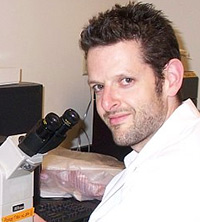Dr. Jeffrey M. Karp
The U.S. News & World Report article Gecko’s Stickiness Inspires New Surgical Bandage said
It’s waterproof, biodegradable, and adheres much better than conventional sutures, researchers say.
“There is a big need for bondable, tape-based adhesives that could be used to seal tissues,” said lead researcher Jeffrey M. Karp, director of the Laboratory for Advanced Biomaterials and Stem Cell-Based Therapeutics at the Harvard-MIT Division of Health Sciences and Technology at Brigham and Women’s Hospital in Boston.
There are other glue-based surgical tapes available, but many are neither flexible nor waterproof, Karp noted. “We decided we needed to create a new material that was elastic, that could conform to the tissue and that could be biodegradable,” he said. “So we created this new material that met all of these requirements.”
To design a material that could adhere to slippery tissues, the researchers turned to one of nature’s stickiest creatures, the gecko. The gecko is able to cling to walls and ceilings using tiny corrugated structures called “nanoscale pillars” on its paws.
Jeffrey M. Karp, Ph.D. is Director of the Laboratory for Advanced
Biomaterials and Stem Cell-Based
Therapeutics,
Harvard-MIT Division of Health Sciences and Technology,
Department of Medicine, Brigham and Women’s Hospital,
Harvard Medical School.
Jeff earned a Ph.D. from the University of Toronto in
Chemical Engineering where he worked with Professor John E. Davies and
Molly S. Shoichet. His thesis focused on developing strategies to heal
critical sized bone defects making use of synthetic degradable polymers,
thrombin, fibrin, platelet rich plasma, and mesenchymal stem cells. Upon
graduation, he was awarded the Paul B. Madsen Award for the most
innovative graduate student.
He joined MIT as an NSERC Postdoctoral Fellow working in Institute
Professor Robert Langer’s laboratory in the areas of human embryonic
stem
cells, photocrosslinkable degradable elastomers, materials for
influencing cell rolling, biomedical adhesives and BioMEMS technologies.
In 2005 he won first prize at an MIT Chemical Engineering Poster
Competition for his work on enhancing the differentiation efficiency of
human embryonic stem cells. Since 2006 he has been a member of the
Editorial Board for the
International Journal of Nanomedicine. In 2007
he was invited to attend the National Academy of Engineering US
Frontiers of Engineering Symposium at Microsoft in
Seattle.
He has published over 27 peer reviewed papers, 8 book chapters, 35
abstracts, and has 16 issued or pending patents — 3 of which have
been
licensed to companies in the biomedical industry.
Jeff coauthored
Microscale Hydrogels for Medicine and Biology-Synthesis
Characteristics and Applications,
Synthesis and Characterization of Photocurable Elastomers from
Poly(glycerol-co-sebacate),
Controlling size, shape and homogeneity of embryoid bodies using
poly(ethylene glycol)
microwells,
A cell-laden microfluidic hydrogel,
Covalent Immobilization of P-Selectin Enhances Cell Rolling,
Development and therapeutic applications of advanced
biomaterials,
Resorbable polymer microchips releasing BCNU inhibit tumor growth in
the rat 9L flank model, and
Nanocarriers as an emerging platform for cancer therapy.
Read the
full list of his publications!





